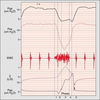| dc.contributor.author | Brochard, L | fr_FR |
| dc.date.accessioned | 2012-08-23T13:57:02Z | |
| dc.date.available | 2012-08-23T13:57:02Z | |
| dc.date.issued | 1999 | fr_FR |
| dc.identifier.citation | Brochard, L, Nouvelles techniques de ventilation artificielle chez l'adulte., Med Sci (Paris), 1999, Vol. 15, N° 6-7; p.798-806 | fr_FR |
| dc.identifier.issn | 1958-5381 | fr_FR |
| dc.identifier.uri | http://hdl.handle.net/10608/1436 | |
| dc.description.abstract | La ventilation artificielle represente l' outil therapeutique majeur de l' insuffisance respiratoire aigue. Son fonctionne- ment et ses effets constituent un domaine de recherche appliquee tres actif, et correspond a l' une des applications les plus riches de la physiologie respiratoire " classique ". Cette recherche necessite parfois l' utilisation de modeles animaux, ou l' experimentation chez des sujets sains, mais implique le plus souvent des etudes physiopathologiques puis des essais therapeutiques sur patients. Les reponses ont des implications therapeutiques immediatement applicables, et parfois des consequences en termes de morbidite ou de mortalite. Par ailleurs, la reglementation administrative - assez souple dans le domaine de la ventilation artificielle (ce qui peut paradoxalement avoir un certain nombre d' inconvenients) - laisse le champ libre aux industriels pour de frequentes innovations et maintes ameliorations technologiques. | fr |
| dc.description.abstract | Mechanical ventilation is the most important life-saving procedure used for the treatment of acute respiratory failure. A large body of experimental and clinical research has been conducted over these last years to better understand and improve patient-ventilator interactions and synchrony. In the field of the acute respiratory distress syndrome (ARDS), much attention has been paid to the potential harm to the lung generated by high pressure, high volume ventilation, as commonly used for ventilating the lungs of these patients. Because of impressive experimental studies and of the fear of inducing an excess in mortality because of barotrauma or the so-called "volutrauma", new targets for alveolar pressure have been defined without paying too much attention to normalizing alveolar ventilation. Ventilating patients with permissive hypercapnia because of reduced end-inspiratory pressures and elevated end-expiratory pressures, have been shown to impact on mortality, although the precise settings and targets are still a matter of debate among the various clinical trials. This modality have been associated with the use of other symptomatic tools, to reduce hypercapnia, like dead-space washout by tracheal insufflation of gas, or to improve oxygenation, like ventilating the patients in prone position. In the field of assisted ventilation, much knowledge has been gained concerning the determinants of patient's effort to breathe under partial assisted ventilatory support. Pressure supported ventilation has been used extensively because of its ability to deliver sufficient peak flow at the early beginning of the breath. A new emerging modality is called proportional assist ventilation and it drastically differs from all previous modes, in that neither the volume, the pressure, or any timing, need to be set on the ventilator. It aims at delivering a support directly proportional to the needs of the patient. Lastly, acute decompensation of chronic obstructive pulmonary diseasesare now treated routinely without endotracheal intubation, by delivering a ventilatory support through a facial or nasal mask. This approach has allowed to markedly reduce the need for endotracheal intubation, and therefore to reduce complications, length of stay and even mortality in this disease. | en |
| dc.language.iso | fr | fr_FR |
| dc.publisher | Masson Périodiques, Paris | fr_FR |
| dc.rights | Article en libre accès | fr |
| dc.rights | Médecine/Sciences - Inserm - SRMS | fr |
| dc.source | M/S. Médecine sciences [revue papier, ISSN : 0767-0974], 1999, Vol. 15, N° 6-7; p.798-806 | fr_FR |
| dc.title | Nouvelles techniques de ventilation artificielle chez l'adulte. | fr |
| dc.title.alternative | New modalities of mechanical ventilation in the adult | fr_FR |
| dc.type | Article | fr_FR |
| dc.contributor.affiliation | Reanimation medicale, Inserm U. 492, Universite Paris XII, AP-HP, Hopital Henri-Mondor, 51, avenue du Marechal-de-Lattre-de-Tassigny, 94010 Creteil, France | - |
| dc.identifier.doi | 10.4267/10608/1436 | |








